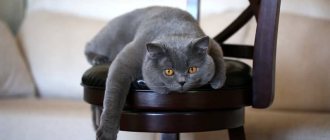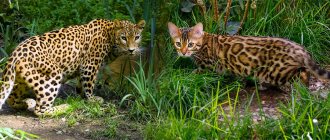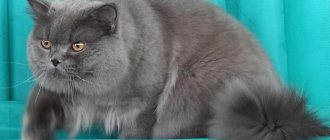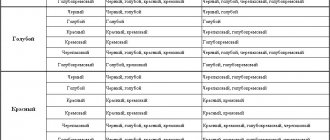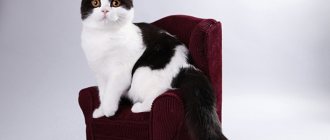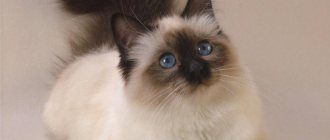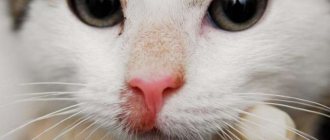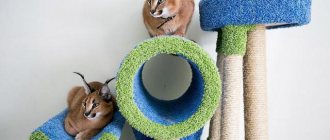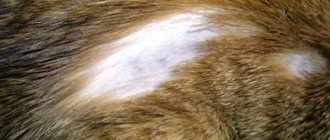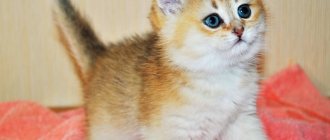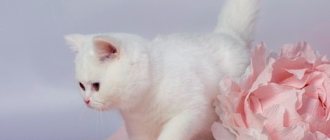Solid colors in British cats are called solid, respectively, cats and cats with a deep charcoal, uniform shade of fur are called “black solid”. Breeding Black British cats is not an easy task, since the fur coat of these animals tends to become overcolored, that is, brown, chocolate or smoky hairs appear on the black fur. Below we will talk about the features of British black cats, their history, character and care for them.
Origin of black British cats
The history of the British with solid solid colors goes back two millennia before our times. It is believed that British cats with fur of different shades were brought to England by Roman conquerors, and for a long time they were common household pets. The classic color of the coat of these animals was blue or smoky, but black and white and completely black individuals were also found. Later, at the beginning of the nineteenth century, owners of black cats decided to consolidate this trait and develop a truly British breed.
Black British teenage cat
The first record of British recognition appeared in 1898. At the same time, the famous British felinologist-breeder Harrison Wyer became interested in the breed. It was through his efforts that the British received different colors: charcoal, red, chocolate.
Origin story
British cats are one of the oldest breeds. There are two legends about how the animals got to the island: according to one version, Roman legionnaires brought them to Foggy Albion; according to another, the cats sailed with French sailors, on whose ships they exterminated rodents. Be that as it may, the furry animals settled in England and became its full-fledged inhabitants. For a long time, they were ordinary street cats, selected only by Mother Nature. Due to the lack of an influx of new blood into the British population, genetic characteristics characteristic only of this breed have formed. The result was large animals with a massive body, charming round eyes and plush, densely stuffed fur that had water-repellent properties.
Due to living in a humid climate for a long time, the British have developed a dense, moisture-repellent fur coat.
Thanks to their intelligence, cleanliness and intelligence, British cats have gained the love and recognition of local residents. Then the work of specialists began on the formation of breed standards.
History of breeding
The British breed was first registered in 1898. Animals were very popular among English bohemians. But British cats of that time were mostly blue, which significantly reduced interest in the breed. At the beginning of the 20th century, people wanted something exotic, and they preferred Persians with a rich range of colors. Breeders, in order to restore the fading interest in the British breed, decided to diversify the color range of the British coat.
Animals of various colors began to be bred to increase interest in the breed
At first, selection work was carried out between new representatives of the breed, but the cats most often turned out were spotted forest colors or there were white spots, inclusions and medallions on the coat. Thus, it was not possible to escape from the basic genotype. Then felinologists began crossing British cats with Persians and individuals of other breeds similar in phenotype, due to which the color range of the British cats increased. In addition to the classic blue and smoky colors, the British have appeared in the most unusual color variations. In 1992, basic breed standards were established, which have remained virtually unchanged since then.
The modern British cat has more than 200 types of colors.
British breed standard
To figure it out for sure, you need to delve into the approved British standard and at least approximately understand what a worthy representative of the breed should look like.
When choosing a black kitten, the future owner must be sure that he is purchasing a British cat, and not a cat with a similar phenotype.
Table 1. External features of British cats
| Parameter | Description |
| Head | As the British say: “The whole breed is in the head.” Indeed, British cats are distinguished by a characteristic large head, round in shape, with wide cheekbones and pronounced “chubby” cheeks. The forehead is round and flat, the nose is short and straight. |
| Chin | Strong, massive, straight (perpendicular to the mirror of the nose). The British jaw should not be narrowed or thin. |
| Ears | Small, low set, rounded at the tip. A Briton's ears should be at an angle of ninety degrees to each other, if the apex of the angle falls on the bridge of the animal's nose. |
| Frame | Short, squat, muscular. Both male and female cats are distinguished by their massiveness, but not looseness. The animals are distinguished by a wide chest and powerful hips. |
| Limbs | Medium length, thick and strong. |
| Tail | Wide at the base and rounded at the tip. Medium length, quite thick. |
| Eyes | Large, wide-set and open. The iris of British cats reaches its final shade quite late, perhaps by the animal’s year. |
| Wool | Thick, dense and shiny, with good undercoat. Ideally, a Briton's fur coat should resemble stuffed plush, so that the animal's skin is not easy to touch. |
What should/shouldn't the head of a thoroughbred Briton look like?
Black color standards
Black color belongs to the group of solid shades, which are also called solid. The name comes from the English solid - solid, solid. Solid colors are divided into seven main groups, each of which has its own code according to European standards.
Table: coding of the main solid colors of the British cat
| Color | Code |
| Blue | BRI a |
| Black | BRI n |
| Lilac | BRI c |
| Chocolate | BRI b |
| Cream | BRI e |
| White | BRI w |
| Red | BRI d |
Black representatives of the British breed are incredibly beautiful and attractive, but quite difficult to obtain the ideal color.
A black British cat's nose and paw pads should be the same color as their fur.
Expert requirements for black color:
- wool - evenly dyed to the very root, thick charcoal color; the undercoat should blend in with the main tone of the coat, shine is allowed;
- paw pads are black or charcoal in color;
- nose mirror - black;
- eyes: copper;
- orange;
- golden.
Features of black British fur
A cat's black fur gets this color due to melanin, or more precisely, its quantity and composition in the hairs. Melanin has two variations: eumelanin (gene B) and pheomelanin (gene A). It is the B gene that gives the animal's fur its black pigment. Also in cats there are two genes (C and D), which are responsible not for the shade itself, but for its intensity. In order for a Briton to have a coal-black, rich coat, D and B genes must be present in his body, and in dominant quantities.
If we talk about the amount of pigment in the fur, then the more of it (that is, the denser the granules), the tougher the cat’s coat will be. That is why the British are so valued because they have sparse pigment granules, making the wool silky and soft, as if plush. However, black Britons have a denser and coarser coat, since the axial, covering hair is densely saturated with pigmentation. This is why black British cats are not plush.
The coat of a thoroughbred Briton shines and shimmers even in artificial light.
Among the British, like many related breeds, the black color is considered complex. This is due to the fact that until puberty (six to seven months) kittens retain brown, chocolate-colored fur. And even when a teenage kitten begins to bloom, it is impossible to say for sure whether it will be jet black.
According to the breed standard, absolutely all the coat of the British, if they belong to the “black solid” color, must be painted in a thick charcoal color, from the very tips to the roots, including the undercoat. The paw pads and nose are also black. White hairs and spots on the coat, rusty spots are not allowed.
The nose, whiskers and whiskers, as well as the claws of black British cats are painted the same color
Birth of black kittens
As we have already mentioned, “black solid” is a difficult color for breeders of British cats. To get kittens with this coat color, breeders select parental pairs whose pedigree contains as few ancestors as possible who had patterned or spotted colors. The ideal would be a cat and a she-cat, which themselves represent one of the solid colors, and their ancestors were also solid colors. It is best if both parents are owners of the “black solid” color - then the chances of success (when expecting a litter of black kittens) will be very high.
However, even if this condition is met, it is impossible to be completely sure that the kitten’s color after recoloring will turn into a charcoal color, and not chocolate or gray. Moreover, there are also reverse “transformations”, when smoky kittens acquired an intense charcoal color as they grew up.
Breed characteristics of black British
The British are rightfully proud of their “signature” British breed of cats - it was bred in Foggy Albion two centuries ago and almost instantly became the most fashionable and popular there. Representatives of the breed received amazing success in 1871 at the famous exhibition in the English Crystal Palace, where British shorthairs of black color were presented - one of the fundamental colors in this breed.
Not every professional nursery can boast of such a chic black Briton
British black cats are second in popularity in the breed, perhaps, only to the famous blue British. They look amazing, and experts at exhibitions often give winning laurels to black Britons - few can compete with them in beauty and showiness. But only specialist felinologists know how much work and experience must go behind the rare success of getting Britons with perfect black fur.
For a long time, English sailors preferred to take black cats with them on voyages - and, as you understand, these were British cats, even if no one knew about this breed yet. Sailors had a superstition that they strictly adhered to: a black cat on a ship is good luck, and good luck certainly doesn’t hurt a sailor. However, the special energy of black cats was appreciated not only by British sailors, but also by the Spaniards - according to some sources, a black cat was also accompanied by a black cat on the famous expedition of Christopher Columbus.
What determines the black color of the British coat?
Color genetics is a very interesting science. And the origin of black color in cats occupies a special place in it. Black is considered one of the most ancient colors in the cat family - it existed long before wild cats became domesticated.
The black Briton looks impressive and mysterious
Monochromatic colors of cats are also called solid - from the English solid (solid, solid). Black solids differ from other solid British ones not only in color, but also in the quality of their wool - it is stiffer and shiny than the matte British “plush” that everyone is familiar with. This happens because microscopic granules of pigment - melanin - are located in the hair “cylinder” more densely than with all other colors. As a result, the hair becomes quite hard and elastic, and not soft and silky, like in the British with a light coat color.
One of two types of melanin is responsible for the black color - eumelanin, the production of which is determined by the presence of the B gene (Black). By being dominant, it gives the coat an anthracite shine and rich blackness - if the dominant gene D (Dilutor - diluent) is also present in the animal's gene set. The recessive form of this gene will result in the coloring of the coat in blurred, as if bleached, and less bright colors: fawn, lilac, all shades of chocolate.
Chocolate color is the same as black, only with the recessive D gene
Thus, the genome of a correct black British must necessarily contain both dominant genes - B and D, otherwise the color will be inexpressive, and the animal, with all its other advantages, will receive the unpleasant status of a breed defect in color.
External features
Black Britons are strong, massive and large cats. The average weight of a mature cat is seven to eight kilograms. Kitties weigh one and a half to two kilograms less than cats.
The black Briton has a powerful physique
The bones of all representatives of the British breed should be wide and powerful, the paws and tail should be short and thick. The muzzle is round, the nose is short, small ears are far apart from each other.
This is what the head of a thoroughbred Briton should (or should not) look like
Experts at exhibitions have high demands on the black color of the British - this is what these beauties should ideally be like:
- shiny, evenly colored from roots to tips, without color gradation or inclusions, with a well-developed undercoat;
- paw pads, whiskers and nose mirror are also painted in rich black;
- eyes - only yellow, preference is given to deep shades (dark yellow and amber, even orange).
A real black Briton is only yellow-eyed
Variations on the Black British Theme
In litters of British cats of various colors, kittens in long-haired fur coats have long been born - this is an echo of the period of the middle of the last century, when Persian blood was actively infused into the breed. Long-haired babies were either discarded or sold much cheaper - as pets, without permission to participate in exhibition and breeding activities. But thanks primarily to the efforts of American felinologists, the British with long thick hair were identified as a separate breed, which in 2009 received authoritative recognition from the international association TICA.
The British Longhair is a young breed, but it has its admirers.
In a young breed, black color is considered one of the most sought after, since long-haired black Britons look especially impressive and are liked by many connoisseurs.
Another attempt to diversify the ancient British breed was, alas, not so successful. Two decades ago, matings between the British and Scots were allowed. In this way, the breeders hoped to improve both breeds: to expand the palette of colors for the British breed, and to improve the quality of the coat and add impressive bulk to the bones of the Scottish breed. Then the so-called British Folds (including black ones) appeared as the fruits of the love of the British with Scottish Folds.
However, the experiment was not successful. There were more disadvantages than advantages - the fold-eared mestizos inherited not the best qualities from the original breeds: for example, diseases of the musculoskeletal system, the basic characteristics of the breed and the quality of the coat also deteriorated; in general, animals began to look less bright and expressive.
British Folds are not recognized as a breed by any felinological organization. Since 2004, the British breed has been considered closed, and mating with Scots is prohibited.
Character and behavior
Black Britons are true gentlemen, aristocrats of their breed. This is manifested not only in appearance, but also in all the habits of this beautiful cat. They are self-sufficient and unobtrusive, have their own opinions on all issues. They are balanced and may seem phlegmatic, but despite their external slowness, they think very quickly and have quick reactions.
They are endowed with a pronounced sense of self-esteem - it’s not for nothing that they are true British. They do not tolerate familiarity, do not seek the owner’s affection, but condescendingly allow themselves to be stroked, and not by everyone, but only by those who deserve such royal favor. Strangers and overly active children are kept at a distance. They never show obvious aggression; they prefer to hide and thereby avoid the conflict.
Black British - comfort and stability in the home
They get along well with other pets as long as they do not try to dominate. They do not feel a constant need for communication and feel great alone.
Everyone who knows black British cats well notes their high intelligence - cats of this color have not only powerful energy, but also an excellent mind
Video: Felix the cat - the perfect black Briton
Breed faults
Black British cats have very few shortcomings, and the happy owners of these cats consider their pets to be ideal. Representatives of this breed are usually long-lived, they rarely get sick and delight their owners with their company for two decades, or even longer. But all this is possible only with proper breeding selection, when responsible breeders thoughtfully form parental pairs, excluding animals with poor heredity from breeding.
The breeder’s task is to get not only beautiful, but also healthy offspring.
What diseases are most common?
British breed cats have a strong immune system, and black British cats, according to breeders, have the best of all. However, all British cats, including black cats, are susceptible to some health problems:
- fungal infections;
- periodontal disease;
- obesity and related problems (heart disease, disorders of the digestive system and musculoskeletal system).
The most serious genetic problem in the UK is the incurable hereditary heart disease - hypertrophic cardiomyopathy. The disease manifests itself in adulthood. A timely identified disease gives the animal a chance to prolong its life - ultrasound diagnostics should be done regularly, starting from the age of one and a half years. All littermates and parents of the affected individual must be removed from breeding programs.
Animals at risk should be examined regularly
Disqualifying faults
The following deviations from the breed standard are considered disqualifying faults for an adult black British dog:
- White spots;
- non-yellow eye color or greenish rim around the iris;
- non-black color of paw pads or nose;
- non-standard number of fingers;
- defects and pathologies of the tail, including kinks and kinks;
- significant violations of the dental system.
A purebred black Briton is the star of any show.
The expert's assessment can be significantly affected by any deviations from the correct black color: its unevenness or insufficient color saturation, elements of the pattern on the coat.
Eye color in black Britons
All British kittens are born blue-eyed, and by the age of three to four months the eyes change shade, turning into their final color. The combination of blue eyes and black fur is not found among the British, since the recessive sky shade cannot appear in combination with the dominant charcoal fur. The classic combination of the British breed is black fur and yellow eyes.
Green eye color, characteristic of many other breeds where black colors exist, is not allowed in coal solid British dogs. According to the standard, the iris of the eye should have one of the shades of yellow, copper or orange.
Black Britons are not even allowed to have a green rim on their iris.
Character of black British cats
Despite the fact that the color of the animal does not in any way affect its temperament or relationship with humans, the owners of black British cats claim that they are more mysterious and mysterious than their counterparts of other colors. Let us note that all British cats are characterized by a sense of self-esteem, a proud disposition and independence.
The British are always happy to have a person's company, although they cannot stand intrusive attention to their person
In addition, it is black British cats that are credited with strong energy, which can even cure some diseases. Patients who have been in contact with British men of solid charcoal color for a long time show positive dynamics in the cure of diseases of the nerves, cardiovascular system, and normalization of blood pressure.
Life expectancy of British cats
What to feed?
British cats are highly susceptible to obesity, so it is necessary to ensure that they do not overeat. You can feed them both natural and commercial food. However, you should not mix them, as this will lead to stomach problems.
There is no need to buy only those foods that are intended for the British. First of all, you need to pay attention to their contents, as well as to your pet. After all, all food is completely different, for example, for castrated or sterilized animals you only need to buy special food that contains neither phosphorus nor calcium. In addition, it will be better if you buy dry food rather than wet food. You need to feed your pets 2 times a day. After eating, the dishes should be washed and only fresh water should be poured, of which there should be plenty. This way you can avoid overeating the animal.
If natural food is used when feeding, it should consist of the following products.
- Raw meat. You can give veal or turkey. There is no need to cook the meat, as it will lose all its benefits. Simply pour boiling water over it and immediately place it in a bowl.
- Fresh or boiled vegetables. It could be pumpkin, zucchini, or cucumber.
- Sea fish, best without bones.
- Eggs.
- Cottage cheese.
- Seaweed, which will make the British fur more silky to the touch.
- Mineral and vitamin supplements, which can be purchased at a veterinary pharmacy.
Contents of a Black Briton
British cats are a fairly easy-to-care breed; if properly maintained, British cats can easily live up to 15-16 years of age without causing much trouble to the owner. Therefore, the key points that the cat owner should know are mainly related to the animal’s nutrition.
Feeding a British cat
The owner of the animal can choose two feeding options - natural food or a diet consisting of high-quality dry food. It is impossible to mix two types of diets, as this is fraught with gastrointestinal problems for your pet. If we talk about industrial ready-made food, then you need to choose the “super-premium” or “holistic” lines, if possible selecting the specific breed of food. Many brands offer food made and selected specifically for the British breed.
Royal Canin for British cats
However, modern food is not necessarily selected strictly for the breed - it is better to focus on the characteristics of the animal (homebody, castrated or sterilized animal, walking on the street, and so on). Each pack contains a table from which you can easily find out the daily dosage of food for a Briton - just weigh the animal and follow the manufacturer’s recommendations.
British cats are prone to obesity, so you should not overfeed your pet or leave food freely available. An adult should be fed twice a day, morning and evening; the rest of the time there should be only clean, cool drinking water in the bowl - this is important!
To prevent your cat from suffering from excess weight, the serving size needs to be adjusted.
The natural nutrition of a British cat is based on fresh raw meat (turkey, veal, rabbit are preferred). There is no need to boil the meat, in which case it loses its beneficial properties, just pour boiling water over the piece before cutting and immediately offer it to the cat.
Food from the master's table is not suitable for the British; there is no need to cook porridge or soups for the cat - they negatively affect the digestive system of the predator. To raw meat you can add grated raw vegetables (pumpkin, carrots, zucchini), quail or chicken eggs, and finely chopped herbs. Every day a cat eating natural food should receive kefir or cottage cheese. You need to remember that in terms of the amount of protein, curd mass is equivalent to meat, and balance the diet based on this - an excess of protein “hits” the liver.
Fresh meat should occupy at least 60% of a small predator's bowl
In addition to meat, dairy products, vegetables and herbs, British cats should receive additional mineral and vitamin supplements - high-quality complex vitamins can be purchased at a pet pharmacy (Canina, 8 in 1, Beafar, Polidex).
British black cats benefit from adding a little kelp seaweed to their daily dose, which maintains and maintains the bright charcoal color of their coat. Dietary supplements for cats containing kelp are also sold in pet stores.
Treats with kelp for cats
Black British coat care
The short but thick coat of a British cat requires some attention from the owner - once a week the cat needs to be thoroughly combed with a slicker brush with droplets on the tips of the teeth or with a special massager. During the molting period, grooming procedures should be carried out more often - once every two days, carefully combing out the dead undercoat. A kitten must be taught to brush itself from a very early age, otherwise a wayward adult cat may resist.
British cats are washed once every six months, or when soiled, if the animal has access to the street or spends the summer season outdoors. For washing, special shampoo for animals should be used. For black Britons, we recommend lines of cosmetics designed specifically for dark coats: “Royal Groom Black Pearl”, “Ring 5 – Black Out”, “Kiss Black Bagheera” and the like.
The British are clean and do not need to be bathed often
Breeding work
It is very difficult to obtain high-quality black offspring in the British breed, and sometimes even experienced professionals cannot predict the result in advance.
Breeding Black British
The choice of a breeding pair is the main issue of any breeding. In our case, it is desirable that future parents meet the following requirements:
- both had a standard black color - even, without spots or shades of color;
- were already untied and previously gave birth to offspring;
- had multigenerational pedigrees from which heredity could be studied.
The ideal parent pair to produce black offspring should be black in color
It goes without saying that at the time of mating both animals must be in good physical and psychological shape, completely healthy, promptly vaccinated and treated for all types of parasites.
Black kittens can be produced by parents with any coat color if they are carriers of the black gene. But a black father and mother, of course, give a much greater chance of getting black babies in the litter. Their wool will be of high quality, and the color will be rich if the pedigrees of the producers contain as few ancestors as possible with light colors: blue, peach, etc. In this case, the presence of striped, spotted and “marbled” ancestors is even more undesirable.
This combination may well produce black offspring, especially if the black parent is prepotent
An important specificity of the British, which must be taken into account when selecting a parent pair, is the presence in this breed of two blood groups, A and B, which it is very advisable not to mix when mating. If you do not adhere to this rule, the litter will be born healthy, but may die within three days. This is due to the fact that maternal colostrum produces special bodies that have a detrimental effect on the blood of “hybrid” babies. In this case, kittens can be saved by immediately switching to artificial feeding.
All British dogs grow and develop very quickly, but puberty comes quite late for them - as, indeed, for all large breeds. Only by four, and in some cases by five years, animals are fully formed physically and psychologically. So early matings are contraindicated for this breed.
Of course, you shouldn’t breed a cat every time she’s in heat - she needs to fully recover from the joys of motherhood. The optimal frequency of successful matings for a British cat is three times in two years. Litters are rarely large, and British cats make very good mothers.
British women are very caring mothers
Issues of castration and sterilization
The British breed usually has high hormonal levels. Therefore, when you decide to take a little Briton into your home, decide in advance whether you plan to get offspring from him in the future - by the way, the class of the animal and its price depend on this. If you are not going to engage in exhibitions and breeding work, it is better to spay or neuter your pet.
This operation will help maintain health, which is especially important for a cat. If she does not regularly bear offspring, then the reproductive system becomes vulnerable to the development of inflammatory processes, which is fraught with the appearance of very dangerous diseases - pyometra and even oncology. After sterilization, animals become much calmer, and cats stop marking their territory.
The optimal age for sterilizing a cat is from nine months to one and a half years, when regular estrus has already begun, but there has been no birth. It is better to castrate a cat at about one year of age.
If you do not plan to breed, sterilize the animal in a timely manner.
Take surgery very seriously. Sterilization (especially of cats) is a full-fledged operation that is performed under general anesthesia and requires time and attention for rehabilitation. Trust this procedure only to experienced specialists and carry it out in a veterinary clinic and not at home. The recovery process must also take place under the constant supervision and control of a veterinarian.
Let's sum it up
Black Solid is one of the oldest varieties of coat color in British cats. Animals of this color look very impressive, especially if the genes “gave” them orange-colored eyes, which are very valuable among breeders. Otherwise, black Britons are no different from their relatives of other colors - they are very gentle, family cats, but want to have their own space.
Video – British black cat
Scottish cat, cat, black smoke kitten: photo, description, coat care
This color dates back to the 1800s (long before the advent of the Scottish breed), but its origins are not known for certain.
Description
The British are considered one of the oldest breeds, and their homeland is England. According to some reports, they came to this country with French sailors and stayed there to live. For many years they were ordinary street cats, and only nature was responsible for their breed. During this time, they developed some genetic characteristics that are specific to this breed. That is, the animal had a huge body, large round eyes, and very dense and water-repellent fur.
In addition, British cats are quite neat and intelligent animals, which allowed them to become favorites of the British. Already at the end of the 18th century, breeders began crossing these beauties with representatives of other breeds. At first their color was only blue, but over time they managed to diversify the color scheme. And at the end of the 19th century, certain standards for cats of this breed were established. These are two main colors that are responsible for the formation of secondary shades: black and red.
A gene such as zumelanin is responsible for the formation of black color. However, for its appearance it is necessary that the British cat has two genes: B and D, but gene B must dominate. In addition, the British can be smoky. Among them, it is worth noting cats with black smoke color. Their fur is black only at the tips, but at the roots it is white. The paws and face are completely black.
We invite you to familiarize yourself with the History of Life on Earth - all about megatheriums
However, a real British cat has an even color, without any transitions or shades. The same applies to the undercoat. An animal's fur can be either long or short. Black British cats are slightly different from their gray relatives.
- They have tougher and brighter fur, which appeared in animals due to black pigmentation.
- The body of the British is quite dense, with a wide back and short legs.
- The front paws have five toes, but the hind paws have only four.
- The tail is long and thick.
- The round muzzle is placed on a wide neck. In addition, there is a fold on it, which only representatives of this breed have.
- British ears are small, with rounded tips.
- Their eyes are huge and wide open.
- The weight of cats can reach up to 10 kilograms, but female cats weigh no more than 6 kilograms.
Description of black smoke cats
Scottish cats and black smoke cats seem not as black as their solid counterparts due to the light undercoat: the hair is not dark along the entire length, but is colored plus or minus half. The color does not seem uniform, but as if it has inclusions or tints.
The Scottish Fold or straight-eared smoky kitten has a color that can shimmer when moving, changing slightly depending on the lighting. Because of this, many inexperienced owners cannot determine what color their animal is - either solid (if the smoke is very uniform), or tabby (if the color is uneven, looks like a patterned one). In fact, these are Scottish smoke-colored kittens.
With age, the smoky color, similar to a tabby, can become full-fledged smoke, or it can remain so patterned. In the second case, we are dealing with an insufficiently good smoky color. Poorly colored smoky shorthaired cats are sometimes confused with tabbies because... it seems like they are striped. However, many people really like this coloring, so if you are not going to take the animal to shows, it is quite possible to buy such a kitten to enjoy its appearance.
You can distinguish black smoke, no matter how good or bad it is, from others by looking at the mirror of your nose. The smoky cat has a black nose without a line, unlike the tabby cat. And in order to distinguish smoke from black solid (solid color), you need to move apart the undercoat and look at the presence of two different colors in the smoke or at solid color in solid.
As an adult, around the age of two, the Scottish Smoky cat has a fully formed color. The lighter the lower part of the hair, the more valuable the cat is. It is desirable that the contrast of colors be uniform throughout the body. Long-haired cats, that is, Highland Straights and Highland Folds, look more advantageous with this coloring - the shimmer is more noticeable on them.
In the international classification, the smoky color is designated by the letter s (from the English “smoke”, which means “smoke”).
There are usually few smoky cats at shows, because... The quality of their color is influenced not only by genetics, but also by many circumstances: they are rarely in ideal shape. At the same time, judges are very picky about the shortcomings of this color, so it is difficult to get a title.
How to choose a Black British kitten
Surprisingly, it's true: many gorgeous black Britons grew up as homely, bad boys. And an absolutely charming black kitten can grow into a mediocre, not at all show-worthy representative of the breed. How not to make a mistake when choosing a kitten?
This is not an “ugly duckling”, but a very purebred British kitten
Don't go for cheap
The British breed is quite popular and numerous; Both on the Internet and at bird markets you will find many offers for the sale of small British birds, including black ones. Often, the kitten comes with documents - nowadays it’s not a problem to “draw” any piece of paper, the authenticity of which most buyers will not delve into.
And everyone seems to be happy: the seller received the money, the kitten received its owners, and the buyers received the desired pet. Well, what will grow out of it will grow... If the deceived owners do not have exhibition ambitions, then the dubious breed of such an acquisition is not the biggest evil. What is much worse is that scammers and breeders are least concerned about the health and proper raising of babies, but here very unpleasant problems can arise.
But this little charm, alas, has nothing to do with the British breed
Don't want to become a victim of scammers? Then don’t give them a chance - listen to these simple recommendations:
- A purebred animal is not bought “cheaply” from random people - competent breeding work is always very expensive, and its results cost a lot of money.
- Contact reputable breed nurseries - professional breeders are responsible for breeding and protect their reputation.
- Buy a kitten under an agreement with the breeder - this is an elementary culture of modern breeding and a guarantee that you will not be deceived.
- Study the breed standard and involve specialists in your selection - if you have basic knowledge about the breed, you will make a conscious, not an emotional purchase.
Read the breed standard
You are ready to buy a black British man - a wonderful choice. What kind of British kitten do you want to buy - short-haired or long-haired? As we have already said above, recently these are different breeds, although they differ only in the length of the fur, and in the main aspects the breed standards are completely the same.
What should you first of all pay attention to in order to purchase a truly purebred animal, and not at least a mestizo or a completely outbred black charmer? It is no coincidence that the British love the saying: “It all starts with the head” - and in our case this is a very accurate definition. The head of a little Briton can “tell” a lot to a breed connoisseur, which will help him make the right choice.
When choosing a kitten, pay attention to the structure of its head.
From the front, the kitten's muzzle resembles an almost perfect circle with small, widely spaced ears and expressive “button” eyes. In childhood, the Briton's head is larger than that of kittens of other breeds, and the ears are smaller. The breed and constitution “give it away” - the body of a British kitten is tightly built, the tail is relatively short, and the legs are short and plump.
Look to the root
Even if all the previous rules were followed and you did get a kitten from a good British family, it is too early to calm down. A decent pedigree, alas, does not guarantee that a cute baby will grow into a cat with the “correct” black color. The fact is that black Britons have an interesting property of dramatically changing colors after a complete change of teeth and the onset of puberty.
Only by seven to eight months of age will it be possible to say with a high degree of confidence what the fur of this teenage kitten will be like. Therefore, if you plan to get a show animal, buy a grown animal whose adult coat is already sufficiently formed.
The grayish childish color of the Briton may soon turn black and sparkling
Experienced breeders have a sign that will almost accurately predict which of the black kittens in the litter will receive the correct and high-quality color when they grow up. If a baby develops the rare “black smoke” color by about two months, then with the final color change, this particular kitten will most likely receive a luxurious fur coat, bright black and sparkling. Look at the very roots of the hairs - if they are lighter there than at the tips, then take a closer look at this baby.
There is hardly any need to worry if single white hairs are found on the coat of a little Briton - they will not remain on the adult coat. Small white pinches or rips will also disappear if the skin underneath is grayish and not pink. But whether the white “medallions”, brownness and unevenness of color will go away - no one can guarantee you this.
Such eyes will definitely acquire an amber color.
From my own experience: I can reveal one more secret that will help you understand at a very tender age whether the baby’s eyes will be a rich, deep yellow color, which is so highly valued among the British, or completely light. It's simple. If a kitten’s eyes are bright blue, a wonderful heavenly shade, as they grow older, alas, they will become faded and dull - a big minus at the exhibition. The closer the color of a child’s iris is to gray, the better colored this Briton’s eyes will be.
Genetics of black smoke color
To get black smoke, a cat must have not only the gene for black coat color B and pigment density D, but also the smoky color inhibitor gene, which blocks the synthesis of pigment in the cells of the hair follicles. As a result of its action, only the upper part of the guard hair is painted, and the root part remains devoid of pigment. As soon as the hair stops growing, i.e. reaches its maximum, the inhibitor gene I (from the word “inibitor”) stops acting on this hair.
However, the inhibitor gene in combination with the gene for density and black pigment is not enough for the animal to be smoky. Such individuals also have non-agouti (aa) genes, that is, genes for non-patterned (non-tabby) colors. The combination of aaII (or aaIi) genes produces haze.
Genetics of color inheritance
There are so many colors of British cats that it’s easy to get confused among them. To organize the diversity of the color range, colors are divided into groups according to coat pattern, color and pigmentation. There are two basic colors that are directly involved in the formation of others:
- black;
- red.
Each color is formed due to a special substance - melanin. The pigment is found in a cat's hair in the form of microscopic granules that vary in shape, size and quantity. Melanin is divided into two chemical subtypes:
- zumelamine (gene B) - spherical granules that absorb light and form a black color (responsible for the black color and its derivatives);
- pheomelamin (gene A) - ellipsoidal granules that reflect light in the red range (producer of all shades of red).
The genes responsible for the offspring being red (O - orange) or black (o - not orange) are located on the X chromosome. The color of the future offspring is directly related to the gender of the parents. Females have two X chromosomes, and males have one, therefore, cats are responsible for three basic colors:
- OO - red;
- oo - black;
- Oo - tortoiseshell (red-black).
Genes located on the X chromosome are passed from mother to children. Accordingly, a red cat will not be able to give birth to black offspring, and a black cat will not produce red kittens. In cats, the color of the offspring depends on which gene is carried on the only chromosome (O or o), the choice is small - red or black. Tortoiseshell cats appear only in cases of pathology and are almost always infertile.
Cats can only be tricolor as a result of mutation.
If a cat has a tortoiseshell coloring, it means there is an extra X chromosome in his code. Characteristic gene mutations occur 1 time in 3 thousand individuals.
British black color
The dominant (dense) gene D and its companion, the recessive (diluted) gene d, are responsible for the color intensity. In order for the B gene (zumelamine) to appear and give a coal-black color, the cat must have the saturation gene D. Thus, for the formation of an intensely colored black color, dominant genes B and D must be present in the pet’s body. The recessive gene d dilutes the black color, makes it is washed out and gives lighter shades.
British black cats differ from their counterparts not only in color, but also in the quality of their coat - it is stiffer and has a characteristic, pronounced shine. This is due to the fact that the guard hair of black animals is more densely saturated with pigmentation. The signature plush coat is not typical for black individuals, but this is not considered a disadvantage.
Black British fur coats are denser and less plush.
The gene responsible for black color (zumelanin) is one of the ancient genes. Black color, along with tabby color, was often found in wild, undomesticated cats. This is why black and striped animals have a number of similar characteristics.
Caring for smoke-colored cats
Smoky cats are very demanding in care, because... In unkempt animals, the fur becomes discolored, fades, and “rusts.” Care means not only regular brushing and combing of the coat, but also a balanced diet, and also protection from frequent, prolonged exposure to sunlight.
It is recommended to wash black show cats with professional shampoos that enhance the black color. And, oddly enough, it is better to wash black smoky cats with whitening shampoos for white cats. The enzymes contained in such shampoos perfectly whiten the root zone, and make the ends of the hair appear shiny.
In addition to shampoo, when grooming, you can use a balm to volume the coat. Then the hairs will be raised and show off the haze more favorably.
You also need to carefully monitor traces of tears, which dry up and become crusts, and after they are removed, if you clean the area around the eyes irregularly, yellowish spots may remain. It will take a long time to get them out. Therefore, it is better to regularly use cleansing eye lotions for preventative purposes as tear stains appear.
Other smoke variations
In addition to black smoky Scottish cats, there are also the following smoke variations:
- blue smoke;
- chocolate smoke;
- smoky cinnamon;
- purple smoke;
- red smoke;
- cream smoke;
- turtle smoke.
Cats are adored for their amazing colors. The “black smoke” color of the cat’s coat is interesting for its unusual nature. The English name sounds like black smoke. Smoky shades are common among many breeds. According to the classification of colors accepted throughout the world, there are several types of smokes: black, tortoiseshell, cream, blue, chocolate, red, lilac.
The haze effect appears due to the pronounced contrast in the color of each hair. The tip is the most saturated shade, and the base is much paler or white.
Description of color
The uniqueness of the color is explained by the work of an inhibitor gene that blocks the manifestation of the coloring pigment. The undercoat and bases of the hairs are devoid of it and are therefore white or lightly colored. The upper part of the guard hair is intensely colored black or charcoal. This type of coloring is commonly called tipping. The degree of concentrated blackening reaches 2/3 or 4/5 of the length of the hair, but not less than 50%. Some breeds are characterized by the presence of a light “collar” around the neck. The complex color looks like a solid, monochromatic one, but when the animal moves, the villi diverge, exposing the light down, and the impression of living, iridescent fur is created. Owners of cats with such wealth note that periods of pronounced pubescence of the pet provide the most mesmerizing spectacle. Kittens may have uneven coat color, which evens out as they grow older.
Breeds with black smoke color
Bearers of the black smoky color are distinguished by golden or copper eyes, charcoal nose and paw pads, black-brown fur with a silver-white down. It seems that such a cat has a demonic attraction. Individuals with this description represent the following breeds:
More often, “black smoke” is found among Persians, British, and Scots. It is important to note that the kitten does not have a final color. Only by the age of 1-1.5 years of life does the teenage coat change, and after some time the adult individual acquires a permanent color variant. The pet needs full care so that the color is not mistaken for another.
Diluted tortoiseshell color
Creamy blue haze
Eyes green or yellow. Shades of light brown and gray predominate (both in the coat and in the skin).
Creamy purple haze
As you already understand, the color gamut standards are similar to a uniform gamut. The difference is in the eyes - here they can be yellow or green.
Tortoise fawn
The eyes are also yellow or green. All other characteristics are similar to those of a single-color fawn. Like its solid-colored cousins, the tortoiseshell smoked fawn is considered “non-standard” and will not take pride of place at exhibitions.
Today we figured out what the difference is between smoky and gray colors. Moreover, all types of representatives of smoky colors were described in detail. As you can see, smoky cats
can be not only gray or brown, but even purple. This piquancy gives them the opportunity to remain favorites of many families in our and other countries. Indeed, cuddling up to such a rainbow-colored and soft creature is more than pleasant.
Characteristic
Black cats are considered the most obedient, kind and responsive, especially when compared with the characters of individuals of other colors. But this is only true for males. Smoky “emers” are often credited with being unobtrusive, but not shy either. They get along well with people and animals. Each breed has its own personality traits. For example, the Scottish representative knows how to make a show by begging for delicacies. The cat stands on its hind legs and, moving its front legs, looks intently into the eyes.
Features of care
Coat
Bearers of this color are quite fastidious in their care. Stress, unbalanced nutrition, dry air, liver disease, etc. lead to dullness, the appearance of spots, a reddish tint in color, and the formation of dandruff. Smokes have a thin, delicate undercoat. Some owners put it “like a cobweb.” It is important for them to carefully comb their fur and use special shampoos and conditioners. Moreover, hygiene products for black cats are not suitable for coal smoke, since they give a tinting effect, and for tipping the main thing is contrast. It is recommended to use AII SISTEM, Bio-Groom, WHITENING products, not forgetting an individual approach.
The wool does not tolerate open sun, it turns brown from ultraviolet radiation, and spots may appear.
Feeding and assistance
Regarding nutrition, the following recommendations are made:
- It is necessary to ensure sufficient dosage of vitamins A, E, D.
- Avoid seaweed, liver, and foods containing yeast.
- Limit prepared foods, as they often lead to contrast blurring.
If problems arise while caring for an animal, you need to seek help from a groomer. This is a specialist who will tidy up not only the fur, but also provide high-quality care for the pet’s eyes, ears, teeth, paws and claws so that it has a healthy and unsurpassed appearance, and while observing the animal, he will give individual recommendations on care and nutrition.
Breeding
This process is not only troublesome, but also pleasant, because as a result, small kittens will be born. Puberty in cats of this breed occurs 9 months after birth. However, you should not do mating right away. You need to let your pet get stronger. It is best to carry out mating after 15 months of life, since if this is done earlier, then all the babies may die during childbirth.
Mating should be carried out only after the second or third heat. The cat should be left with the cat for several days. On the first day, the animals are just getting to know each other. A British woman's pregnancy lasts up to 9 weeks. The first signs are swollen and pinkish cat nipples. In addition, she eats a lot, and after 5 weeks her belly will increase significantly.
You definitely need to take care of the place of birth. It must be fenced off from the rest of the space and covered with soft cloth.
To obtain black offspring, the owners will need to work a little, especially in choosing a partner. Let's look at some rules:
- Only black individuals are chosen for mating;
- there cannot be gray relatives in the pedigree;
- both pets must be absolutely healthy and have the necessary vaccinations;
- Before mating, cats need to be treated for parasites.
If the owner does not know how to get the desired result, then it is best to turn to specialists who will be able to choose a worthy partner for their beloved pet. In addition, you can familiarize yourself with the breed compatibility tables, which were compiled by advanced specialists.
- If one pet is black and the other is tricolor or bicolor, then the future offspring will consist of half black kittens and half bicolor kittens.
- If mating is carried out between bicolors and tricolors, then their offspring may be unpredictable. Half of the kittens will be bicolor, 25% will be black, and the second 25% will be born almost white.

